Do you also have a little Tarzan at home who enjoys climbing on the furniture? Children love to pull themselves up onto things and climb across whatever gets in their way – the couch, the bookshelf, the kitchen table. This isn’t just a random thing all kids have in common, but is, in fact, a product of evolution. Along with running and jumping, climbing is one of the natural forms of human movement – it’s just that as adults today, we hardly ever need it. Proof that we could, however, is evident in the “climbing muscle” that most of us still have attached to our wrist. The palmaris longus muscle is a remnant of the genetic ancestors of humans and apes. Likewise, the instinct to climb is ingrained in our DNA.

So it’s a good thing that climbing is so beneficial to our kids – it keeps them fit (including mentally), makes them more social, and has numerous other benefits that we’ll discuss in detail throughout this article. We’ll also provide tips on what to look for when buying a jungle gym, where and how to set it up, and how to ensure your kids get the most enjoyment out of it.
Fit and Healthy
It’s hard to imagine public playgrounds without jungle gyms, which offer children a range of opportunities to move – the little ones can do gymnastics on them, hop from platform to platform, climb up the outside frame, shimmy from pole to pole, balance on them, or casually hang off of them. Anyone who sees how much fun kids have on them will definitely want one for their own backyard, or even for their home. In this case, the jungle gym will probably be somewhat smaller than the one at the playground, but it doesn’t matter – you can just make your structure really complex and in doing so, offer the same features, provided you have enough space. :-)
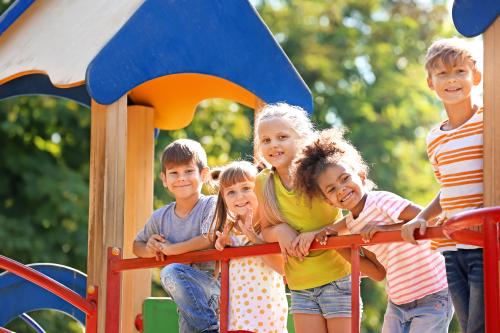
When children play and climb around for hours on a jungle gym, it’s great for their health. Exercise in general promotes healthy bone development, trains muscles and tendons, boosts metabolism, and enhances circulation. It also strengthens the heart and lungs, even more so when your kids are outside exercising in the fresh air. The complex movement patterns enhance children’s:
- Athletic and fine motor skills
- Coordination
- Sense of balance and equilibrium
- Body control and physical awareness
- Reflexes
- Spatial awareness
- Design sense
- Sense of planning and budgeting with the available parts
- Spatial thinking skills
- Ability to coordinate colors

Whereby the last four points only apply to modular jungle gyms, i.e., those that are assembled out of individual elements. This is because the children have to imagine in advance what the structure will look like later, and also think about which tubes they will stick together and how. They face an added challenge when the individual parts come in different colors. In this case, they’ll need to stick the pieces together as shown in the assembly instructions – which trains their color coordination. Or, if they feel like it, they can just put the colors together randomly.

Nature has designed children’s bodies to move, and move a lot – for example, their bones are softer and don’t break as easily. Cuts and bruises heal faster because the thymus gland, which is particularly large in children, secretes peptides that accelerate wound healing and ensure that children’s bodies are constantly being repaired. And that’s a good thing, because it means minor falls won’t harm the young explorers – they simply dust themselves off, get right back at it, and keep trying things out, always on the lookout for new, exciting experiences.
Climbing Kids Are Happy Kids
A lack of exercise, which is unfortunately widespread nowadays, causes stress, a depressed mood, aggression, anxiety, self-doubt, fatigue, and difficulty concentrating in children. That’s why it’s important to encourage your kids to move a lot and often. A jungle gym at home can act as an additional motivating factor in this regard.
But why is exercise so good for our little ones anyway? First of all, it supplies their bodies with more oxygen. This allows the brain to develop more easily, which in turn leads to them doing better in school. According to studies, children who get enough exercise are more focused, alert, receptive, and resilient, and can remember things better. New experiences are known to stimulate the formation of new neural connections in the brain.
Since motor and language skills are mutually dependent, climbing also promotes linguistic development. As such, the brain’s language center is connected to its center for fine motor control. Accordingly, experts believe that children who exercise a lot also tend to exhibit better linguistic skills than couch potatoes. Amazingly, climbing can even help kids with their math homework. Researchers believe that having good body control and confident spatial awareness can also improve the ability to navigate in other spaces, such as when working with numbers.

Outdoor activities such as climbing in the backyard at home help strengthen children’s immune systems overall. During the oral phase, which usually lasts until children are two years old, babies put everything within their reach into their mouths. This means they come into contact with quite a few germs and bacteria, but this isn’t a cause for concern. In fact, the opposite is true – germs and bacteria strengthen the child’s immune system. Playing outside, where things aren’t quite as sterile as at home in front of the TV, fulfills a similar role.
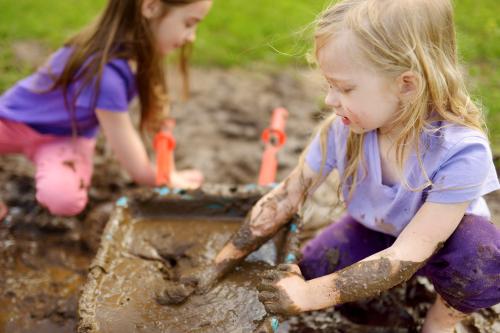
If you’ve ever watched kids playing on a jungle gym, you’ll know that it involves a lot of laughing. Compared to adults, children laugh 30 times more often a day – and this not only has a positive effect on their immune response, but also on their overall mood, of course. They’re more relaxed, more at ease, they simply feel good. During exercise, the body releases endorphins, a kind of endogenous drug. It’s not for nothing that endorphins are referred to as “happy hormones” – they reduce stress, anxiety, aggressive behavior, and generally lift our spirits. The result is that climbing children simply feel comfortable in their bodies. Due to the release of endorphins, they even feel less pain. Fidgety kids become more well-adjusted and calm again, which makes them nicer people to be around overall.
Building Something with Friends
Youngsters who can play and climb outside to their heart’s content are more open-minded and more emotionally intelligent compared to homebodies. A jungle gym in the apartment or in the backyard automatically becomes a meeting place for the neighborhood children and playmates from daycare or later also from school. This helps them form important bonds and develop social skills. Studies show that friendships promote the development of a child’s identity and increase self-confidence – making it easier for adolescents to cope with the increasingly difficult challenges life throws their way. When children design and assemble the jungle gym they plan to build together, they learn what it means to work and cooperate with each other as a team. In the process, they gradually create the stage upon which they can then act out exciting scenes that they’ve seen on the Internet, on television, or in real life.
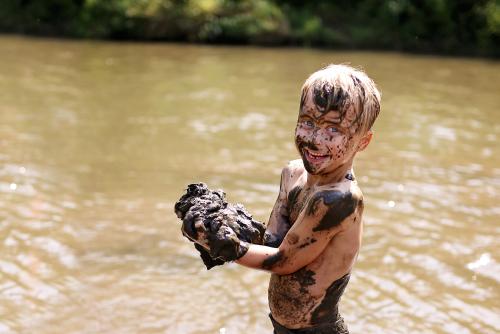
Role-playing games have an important place in children’s lives. Not only is it incredibly exciting to slip into the role of a swashbuckling pirate, a beautiful princess, or a hardworking newsstand owner – this type of game serves many other functions and is important for children’s development. Besides stimulating their imagination and creativity and therefore boosting their intelligence, when children play in groups, they develop their communication and social skills. They learn to defend their opinions, to look for solutions together when a conflict arises, or to take sides with a child who may be disadvantaged. In this way, they develop their empathic capacity and see the world from different perspectives, can identify with other points of view, and in doing so, practice tolerance and thoughtfulness. In addition, they gain a better understanding of the adult world (role-play is where children’s first career aspirations emerge) and are better able to process everyday events by reenacting them. During role-play, they learn in a playful way that sometimes you have to stick to agreements with others in order for things to work. And even if the jungle gym may not look like a space station to you, don’t worry – children have enough imagination and can create entire worlds in their minds out of remarkably simple means.
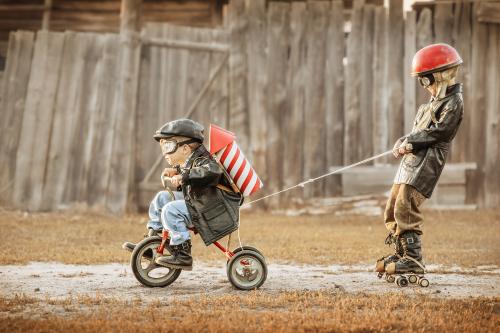
What Kinds of Jungle Gyms Are Available?
Fortunately, in addition to the giant jungle gyms found on playgrounds, there are also those for home and backyard use that offer just as many benefits to little climbers. The good news is that jungle gyms aren’t just for climbing – they can be augmented through the addition of various extension elements. You can surely imagine how much fun it is to whoosh down an attached slide after climbing up a climbing pyramid. At the bottom, your little munchkin then lands on the carpet or in a ball pit – and outside, on the grass or even in a sandbox that can be attached separately. Or, if you have one, in the pool! The structure can be expanded to include a swing, climbing ropes, or maybe a bouldering wall – then you’d even have a genuine climbing tower on your hands. Some manufacturers also offer canopies to provide protection from the rain or sun.
It’s important to choose the jungle gym so that it fits the size and age of your children. Many models are designed so that you can make changes to the frame as your children grow and their abilities develop. Modular jungle gyms are especially practical – they’re easy to assemble and disassemble, which means they can be used outside in the summer and inside in the winter. You and your child can repeatedly take them apart and then put them back together again in a different way – a surefire solution to keep boredom at bay. But most importantly, the structures keep pace with your children’s development, as their width and height can be expanded (although there’s a limit to their height, more on that later).
What Materials Are Available?
Metal
The individual elements of a jungle gym are generally made of plastic or wood. You don’t usually find metal jungle gyms in backyards or on public playgrounds nowadays because they quickly take on the ambient temperature around them. This means they become either extremely hot or extremely cold, posing a potential hazard to children’s delicate skin. In addition, they hardly cushion falls at all. Another feature of metal structures that makes them unappealing is the fact that they can rust, especially if the protective coating has come off or the alloy is damaged. Rusted metal jungle gyms need to be taken apart and thrown away.
Wood
Similar to metal, wood has limited cushioning properties. Models made of wood are only eco-friendly if the wood was grown sustainably. Their environmental friendliness is also related to whether or not they’ve been treated with additives. Unfortunately, this generally can’t be avoided, since a protective coating is used to prevent the jungle gym from absorbing water. If water penetrates the wood fibers, they begin to rot – and at some point, the wooden structure is going to end up in the trash. Wooden models, especially inexpensive ones, are often treated with strong chemical additives. You can tell if a jungle gym has been treated with such substances by the smell – additives used to preserve wood have a powerful odor. Next time you’re at the hardware store, just take a whiff of something made out of wood and pay attention to whether it actually smells like wood – or something else.

Wooden models, even high-quality ones, usually also have some rough spots. Wooden jungle gyms often crack, which can lead to splintering and thus an increased risk of injury. This is why you should regularly check your jungle gym for rough spots, smooth them out, and soften them up with some sandpaper or a sander.
Plastic
One thing needs to be pointed out right off the bat: not all plastics are the same. That's why it’s important that you find out the properties of the product you’re considering in advance, and only buy products that meet the highest standards and are completely safe for your children. The main advantage of plastic is its durability – high-quality models can be used for generations, which makes them particularly sustainable. Since the design is usually timeless, it’s not uncommon for children to happily accept jungle gyms from the previous generation. Another major advantage is that plastic products are easy to clean. How often do kids grab onto the jungle gym with their hands full of jam or ketchup? Exactly. But you can remain calm with a model made of plastic, because bits of food can easily be removed with water. When set up outside, mud and inclement weather are also no match for the structure. In this case, you can simply wash the jungle gym down with water using a garden hose or pressure washer, for example. Another advantage is that plastic doesn’t absorb water, so you can take the jungle gym back inside after using it outdoors without it leaving unsightly marks on your light-colored carpet. Models made of high-density plastic, unlike wooden models, also don’t absorb foreign odors that would make them unsuitable for indoor use.
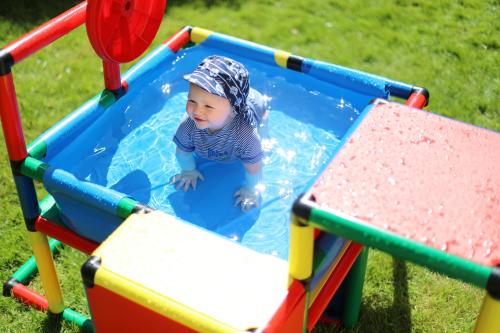
High-quality formed plastics don’t have any sharp edges or rough spots. Furthermore, plastic models don’t use the steel nuts and bolts found in wooden models – instead, they feature simple plug-in connection systems. This means you don’t need protective caps to cover these parts of the jungle gym. Tubes and panels made of plastic give if your child falls on them and then return to their original position as if nothing happened.
Make sure plastic products are resistant to acids and bases – that way they’ll survive summertime in a pool especially well. They should also withstand UV radiation well so that they don’t fade prematurely. You can go by whether the plastic your jungle gym is made of has been formulated with UV protection and a color masterbatch (an additive used for coloring plastics). Both together make the structure more durable – manufacturers of products made of such plastic often offer a long warranty.
Seal of Approval
We recommend only buying certified products for the little ones. The best thing to do is to look for seals of approval such as the GS mark, which is awarded by bodies such as TÜV, DEKRA, SGS, or Intertek and certifies the jungle gym’s load-bearing capacity, stability, and workmanship, and therefore its compliance with CE testing regulations. When it comes to workmanship, the certification process includes verifying that the jungle gym doesn’t have any sharp edges and that the wood has been sanded smooth, among other aspects. In addition, the product’s packaging, assembly instructions, and documentation are reviewed, as well as the production or manufacturing facility, and, of course, the overall mechanics, design, etc.

One thing to be aware of is that a CE marking doesn’t necessarily mean anything, since it only confirms that the manufacturer has complied with European safety standards – but the manufacturer’s declaration hasn’t been verified by any external body.
Selecting the Right Surface
You should always set up the jungle gym on a flat, smooth, and solid surface – this will ensure that it remains stable and secure. Some models have additional floor anchors that provide added support. Don’t set up the jungle gym on hard surfaces, such as concrete, cobblestones, or granite. This increases the risk of injury, particularly in the event of falls. Grass is ideal for jungle gyms up to 150 cm (approx. 5 feet) high. If they are taller than that, choose a surface with much better cushioning properties, such as wood chips, bark mulch, sand, or gravel. Indoors, a non-slip carpet is a good choice. Special fall safety mats designed to cushion the impact of your children should they ever fall off the jungle gym are even better. The mats should be HIC-approved.
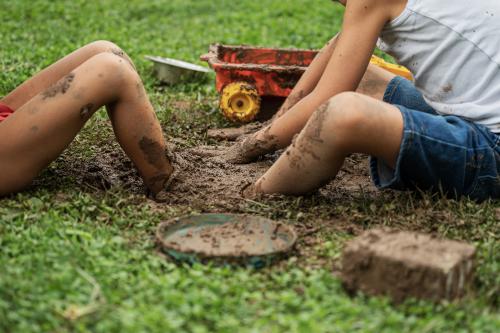
Selecting the Right Location
If you’re setting your jungle gym up outside, make sure there’s enough clearance from adjacent buildings, fences, plants and shrubs, paved paths, or other landscaping elements. We recommend a minimum distance of two meters (6.5 feet). The same applies to indoor models, which should also be at least two meters (6.5 feet) away from radiators, cabinets, and other furniture. By having your own jungle gym, you are effectively moving the place where your children play from the forest or playground to your own backyard or living room, and you can decide for yourself how you want to set up the structure and the environment in which it is placed. This means you have to decide for yourself what might actually pose a risk – and what doesn’t.
It isn’t a good idea to set up the jungle gym outside in the yard in the blazing summer sun. A better spot would be under a large tree that offers plenty of shade. Alternatively, you can also create enough shade yourself using a sufficiently large awning.
Children, especially young children, should never play on a jungle gym completely unsupervised. You should either be right there or set up the jungle gym where you can immediately intervene in case of an emergency. This means that you shouldn’t position the jungle gym behind trees or other plants. Also, it’s better not to put it in the front yard or close to a street unless you can make sure your kids don’t run into the street.
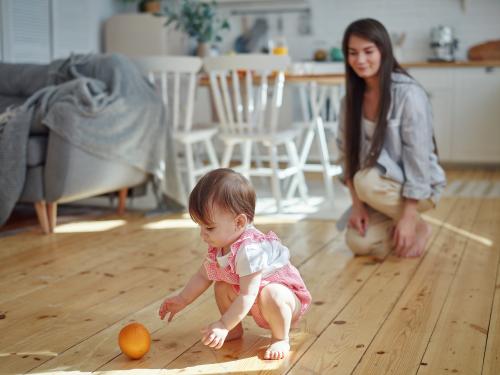
Jungle Gym Height
The ideal jungle gym height generally depends on the size of your children. The younger and smaller they are, the lower it should be. As children get older, higher models are a good idea, especially since jungle gyms that are too low quickly become boring for older children. An expandable structure can grow with the size of your children and adapts to their development – allowing them to gradually master new challenges. But jungle gyms shouldn’t be taller than 2.5 meters (approx. 8 feet).
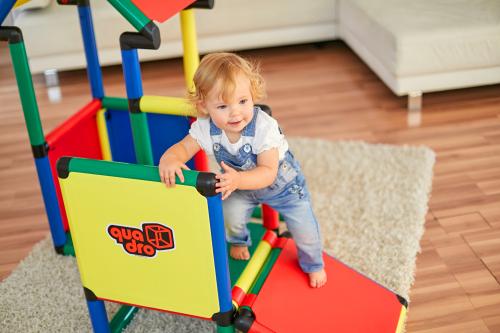
Control is Good – Basic Trust Is Better
As mentioned above, you should always supervise children, especially young and inexperienced climbers, when they’re playing on a jungle gym. Over time, you’ll get a feeling for whether they have everything under control. Encourage your kids to climb, but don’t push them to try to do more than they’re comfortable with. Children are usually capable of judging for themselves what they can and can’t yet handle. It’s crucial that you don’t project your own fears onto them – this leads to self-doubt and a lack of self-confidence and has a negative impact on their later lives. So do your best to avoid rattling your children by saying things like “be careful not to fall down.” Besides, all it really does is distract them and make it harder for them to concentrate on climbing. Instead, just let things run their course – but always be in a position to intervene immediately if your little sweet pea does end up overestimating his or her abilities. In this way, you also strengthen your children’s sense of basic trust, which has a huge impact on their self-esteem and positive attitude towards life. This will ensure that they develop into stable individuals – and usually remain that way for the rest of their lives.
Conclusion
In addition to making their day, month, and year all at once, buying your children a jungle gym is also great for their physical, mental, and social development. Once you’ve found a design that suits your kids and have made the initial decision on where to set it up, there’s nothing else standing in your way. Maybe you’ll build a climbing pyramid? Or how about a pirate ship? A castle for a princess? No matter how the jungle gym ends up, your little monkeys are sure to be delighted!
Why We Wrote This Article: Jungle Gyms Aren’t Just Our Business, They’re Our Passion
We have an extremely clear idea about what really good toys should be like – and we don’t stop thinking about them after they’ve been manufactured and sold. We spend a lot of time pondering what’s good for kids. We want our readers to benefit from our knowledge and experience so that they can also become familiar with points of view other than those that we’re exposed to every day in our modern world. We have big plans – and have therefore already started to implement our vision of really great toys.
Needless to say, we stand behind our products 100%. And it isn’t just independent testing institutes that share our opinion, but also countless climbers in every industrialized nation around the globe. Some of them are likely now over 40 – after all, QUADRO has actually been around since 1979. Many of our customers grew up with QUADRO and have fond memories of playing on our jungle gyms when they were young. And many a QUADRO set from the 80s or 90s is still in use today, maybe with a new climbing pyramid or an Adventure Set added so that the original customer’s children can also enjoy the wonderful toy.

Similarly, our patented PLUG-IN SYSTEM, which allows the structures to be expanded as desired, has been around for just as long. This makes it possible to design a new jungle gym at any time or in a different location (indoors or outdoors) and theoretically build a new model with it every day – transforming a tunnel into a maze that later turns into a castle or a tower. Or maybe into a cave, a raft, or a soapbox! The jungle gym’s complexity adapts to the age and abilities of your children. QUADRO models grow with your kids and are easy to expand, so they offer plenty of opportunities to get creative and make them bigger and better. The structures automatically become the starting point for all of your child’s early adventures – from 6 months of age into their teenage years. The tubes are ideal for small children’s hands and feel warm and pleasant to the touch, but they’re also sturdy so that older children can roughhouse on them without any problems. As a general rule, the more components a jungle gym is built out of, the more options and challenges are available to the little climbers.
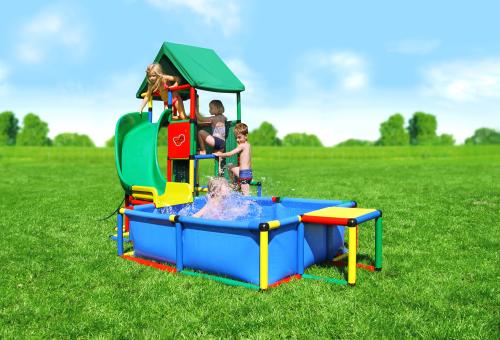
Additional elements such as slides, ramps, ball pits, pools, goal nets, and fabric roofs can be added to any QUADRO model at a later time. Or you can build a vehicle with your kids that you came up with together. All QUADRO kits are fully compatible with each other, even backwards to 1979. A major advantage is that you can replace damaged parts at an affordable price – other manufacturers of jungle gyms usually don’t offer spare parts at all. In addition, a model database is available that contains a wide range of possible designs and suggestions.
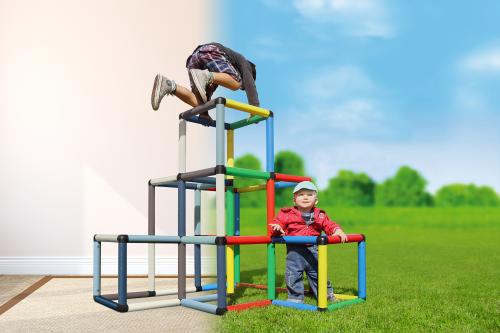
This way, you don’t have to buy a different toy every season because the old one has become boring in the meantime – which isn’t just sustainable and environmentally friendly, but also wallet friendly as well. All QUADRO products are made of high-density plastic that meets the highest standards. The production, packaging, warehousing, as well as further development and worldwide distribution of all QUADRO products is carried out exclusively in Germany. QUADRO products are manufactured from high-density polyethylene (HDPE, recycling code 2) and polypropylene (PP, recycling code 5). Polypropylene, which consists solely of carbon and hydrogen, is particularly regarded as a neutral, safe, and environmentally friendly alternative plastic. QUADRO only uses materials that are free of harmful chemicals such as PVC, PAH, BPA, and plasticizers, making them fully recyclable. They are completely odorless and are therefore suitable for both outdoor and indoor use.
In addition, QUADRO jungle gyms are dyed completely through to protect them from the effects of UV radiation. As a result, the colors fade much slower than those of comparable products and the material retains its original properties longer. It’s also resistant to chlorine, salt water, acids, and bases, meaning you can set up a QUADRO slide in your pool in the backyard without a second thought – creating a killer waterslide for your kids.
The stability and durability of our products play a particularly important role in terms of sustainability. As you know, most children aren’t exactly gentle with their toys. They step on them, fall over them, and often leave them in places that cause you to trip over them. QUADRO tubes and panels are designed for many years of play, are particularly thick, and can withstand quite a lot of weight (the tubes up to 100 kg (220 lbs.), the panels up to 50 kg (110 lbs.)). That’s why we offer a 6-year warranty on our entire range. Our toys aren’t designed to break any time soon, forcing you to go out and buy something new. We promise!
You can have fun climbing in more places than in German children’s rooms. Here a QUADRO jungle gym ended up in Portugal, here in Qatar – and here at a German school students even climb the jungle gym during class.
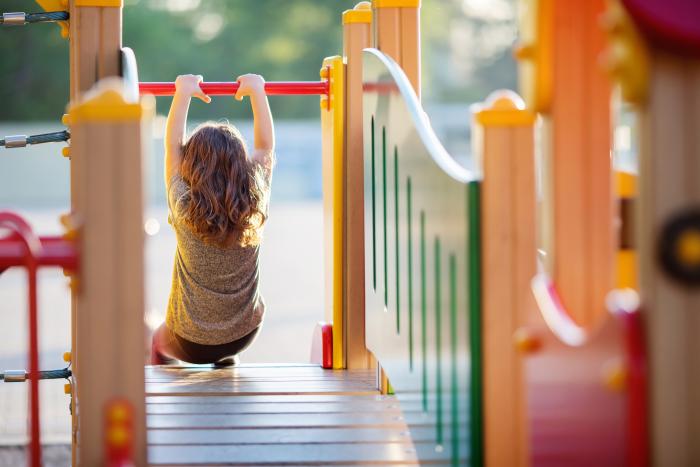
Komentarji